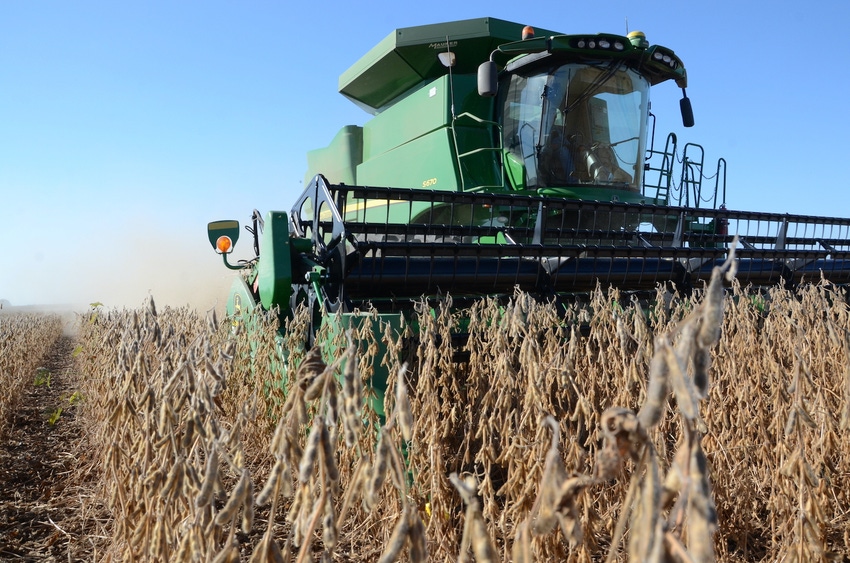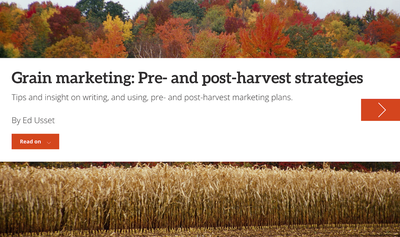August 5, 2022

In any year, no matter the price of the crops you’ve raised, marketing still matters. Getting your program organized ahead of harvest and when you’ve parked the combine can put more cash in your bank account. A new free report from Farm Progress and Farm Futures offers an in-depth, but easy to use, guide tackling those pre- and post-harvest grain marketing challenges.
Authored by Ed Usset, marketing specialist at the University of Minnesota Center for Farm Financial Management, he authored “Grain Marketing is Simple (It’s Just Not Easy)”, this report pulls together several marketing columns he authored for Farm Futures into one handy-to-use reference.
Here’s a rundown of the report and what it offers.
How to write a pre-harvest marketing plan
If you’ve been putting your plan together based on price targets that may limit your opportunities. Likewise building that plan around decision dates may not offer the right flexibility for your farm business. The key is to build that program around both.
The report looks at how to scale up price targets. When setting those targets the maximum should be aggressive and realistic. The report digs into that concept using detailed examples of pricing strategies Usset uses to model the approach.

Download the free report: Grain marketing: Pre- and post-harvest grain marketing strategies
After setting the price the next step is to work on decision dates which are times when you commit to pricing portions of that grain crop even if the price target has not been met. The key is to lock grain sales when the price is above your minimum.
And Usset answers the tough question: What element takes priority, the price target or the decision date?
A simple pre-harvest grain marketing plan, part 1
In the report, Usset turns to trusted examples of different marketers and their strategy. In this section he looks at what he calls the “simplest of all” marketing plans. Using his celebrity producer Aunt Tilly as an example, Usset compares her use of pricing new crop corn and soybeans early to that of Barney Binless who markets all his grain at harvest.
Aunt Tilly’s approach to pre-harvest marketing beat the harvest price by 16 cents per bushel in corn and 24 cents per bushel in soybeans. As Usset notes gaining 16 to 24 cents per bushel on every bushel produced over the past 32 years is not small change.
Usset notes Tilly’s approach is not perfect but her win rate over the “sell all of it at harvest” is impressive. Tilly’s early pre-harvest sales approach beat Barney’s by more than 10% in 17 and 10 years for corn and soybeans respectively.
Throughout the report, Usset offers charts and tables detailing each approach and how it performs.
A simple pre-harvest grain marketing plan: Part 2
While Aunt Tilly’s performance can be solid, there are times taking the tactic of early sales without setting a minimum price can crimp returns in soft years. The minimum price set should be consistent with production costs.
Download the free report: Grain marketing: Pre-and post-harvest grain marketing strategies
Next Usset turns to Terry Timer, like Tilly she prices 80% of her anticipated new-crop corn and soybeans in 20% monthly increments, March to June and the remaining 20% at harvest. But Terry has a minimum price objective for new-crop corn and soybeans consistent with her breakeven cost.
This can lead to dramatic results. Usset uses Tilly as an example of pricing grain without setting a minimum. She was pricing corn and soybeans in 2020 when the pandemic-induced crash cut Nov. 20 soybean futures to as low as $8.50/bu. And Dec. 20 corn futures below $3.50/bu.
By having a minimum price Terry waited and benefitted from higher prices at harvest. That minimum price objective adds discipline to Tilly’s approach.
Help with your post-harvest grain marketing plan
One of the approaches Usset uses is to model different approaches and help identify which might be best for your farm. In this section he digs into the question of “to store or not to store.” He uses three marketing friends to show different approaches.
Barney Binless, May Sellers and Early Eitheror. By their names you get a sense of how each approaches grain marketing.
May Sellers has on-farm storage so holds unpriced grain to sell next spring. Earl Eitheror also has on-farm storage and at harvest he has a choice. This gives him flexibility to use different marketing tools to lock in the price of his grain. Usset details those approaches.
Barney Binless, alas, has no bins. He’s selling at harvest. Using these three approaches, Usset shows the impact of carrying charges for grain and what they mean to your marketing plan.
Usset shows the results of each strategy over 31 years showing how each performs and shows the winners and losers in each strategy. A key to this strategy is understanding the impact of the carry in the market.
Decision tree for post-harvest grain marketing
Sometimes the action of selling grain becomes a decision nightmare. Should you store? Sell? What factors impact each decision? Usset helps answer that question with a decision tree which helps a producer work through how to set up the post-harvest strategy by going through a few simple steps.
Usset takes the examples of May Sellers, Barney Binless and Earl Eitheror to the next level in this section digging into external market factors and how they impact returns. The decision tree becomes the framework for the section helping define the best choices for marketing grain in the face of a volatile market.
Download the free report: Grain marketing: Pre- and post-harvest grain marketing strategies
This section asks some key questions about market positions and prices the pulls together some key calculations to help make decisions easier. One factor is calculating your grain carrying charge, which can help drive marketing decisions for the current season.
Download the free pre- and post-harvest grain marketing report and work through Usset’s examples, which provide a detailed roadmap to help lock in solid pricing for your corn and soybean crop.
About the Author(s)
You May Also Like






